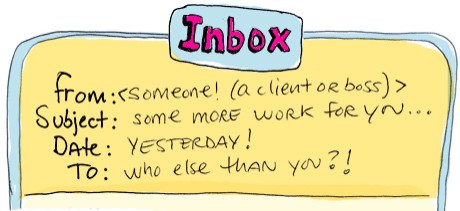A shoddily composed email can affect your receiver’s perception of you and undermine your credibility. Although it seems like writing a clear, concise, language-appropriate email has become something of an art, everyone can master the basics. Here’s how to approach professional email-writing:
Step 1: Subject line
“Business people receive an average of 108 emails per day,” points out Matthew Held at the Huffington Post. A clear subject line may be the key to getting the person at the receiving end of your email to, well, open it. If anything, the clearer the subject line, the faster it is for the receiver to understand what you’re referring to - and find the email again in their inbox.
A good subject line will summarize the rest of your message and be as specific as possible. Compare these two examples from Held’s piece. “Re: budget meeting” is does not specify your purpose for writing the email beyond the meeting. An improved version could read something like: “Draft agenda by 11/21/08 re: budget meeting.” Note how it begins by stating the action required (the draft agenda), followed by a specific deadline, and finally mentioning the context.
Step 2: Greetings
Always open your email with a greeting. Depending on your relationship with your receiver, you will want to evaluate the formality of your greeting. In a professional context, opening with Sir/Madam, Dear [Mr./Mrs.], or Dear [First Name] are generally good ways to go.
Step 3: Email body
State the purpose of your email within the first two sentences, recommends career and workplace expert Lindsey Pollak. Your email should be short, sweet and easy to read: “Write concisely, with lots of white space, so as to not overwhelm the recipient,” she writes for Inc. Break up your email with short paragraphs or even bullet points.
“Watch your tone” when composing your email, warns Bishop’s University on their Email Etiquette tips page. “You want to come across as respectful, friendly, and approachable,” not “curt or demanding.”
Step 4: Endings
The same rules for beginning an email apply here. When in doubt, Held recommends sticking with one of the following: “Best,” "All the best", "Best regards", "Best Wishes", "Sincerely", "Cordially", or "Yours".
Always include a signature, recommends Lindsay Held. That way your receiver does not need to waste time searching for your contact information.
Step 5: Reread your email before it goes out!
“Pay attention to basic rules of grammar,” Bishop’s reminds us. Proofread your email carefully, checking for incorrectly spelled names, typos and grammatical errors.
Step 6: Make judicious use of the Gmail “Undo send” option
If you are the type of person who only catches an error in an email once it’s been sent, you should consider enabling Gmails “Undo send” option. Here is how to enable it. But remember: “Undo send” only gives you a couple of seconds of leeway, so it doesn’t replace careful composition and proofreading.
 Art by Marie-Chantale Turgeon, used via Flickr Creative Commons license.
Art by Marie-Chantale Turgeon, used via Flickr Creative Commons license.